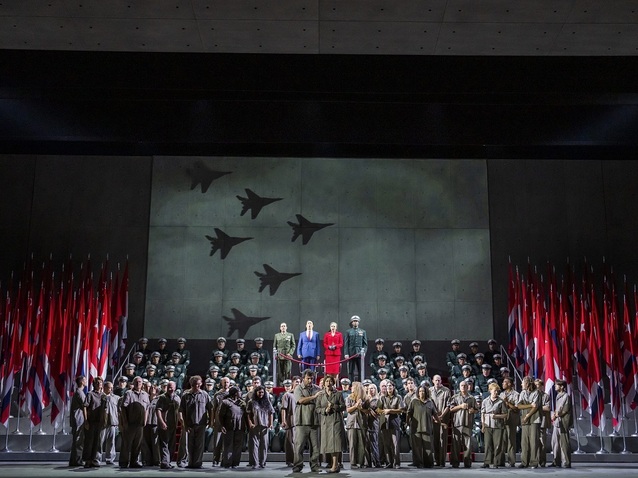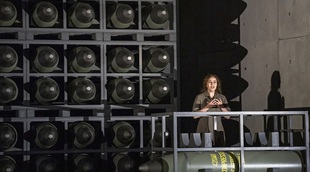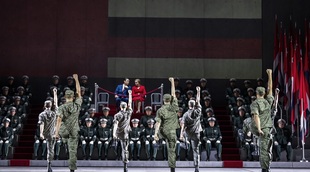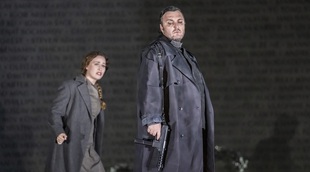 © Tristram Kenton
© Tristram Kenton
Set in Ancient Egypt, Giuseppe Verdi’s Aida of 1871, with a libretto by Antonio Ghislanzoni, centres on a love triangle between Radamès, Amneris and Aida. As a Princess of Egypt and the daughter of the King, Amneris believes that her feelings for the Chief of the Guard Radamès ought to be reciprocated, and is horrified when she discovers that he and Aida, an Ethiopian slave, are actually in love.
When Aida’s father Amonasro is captured in battle, with the Egyptians not realising that he is the King of Ethiopia, the slave finds herself torn between her private love for Radamès and her public responsibility towards her people. Amonasro wants Aida to use Radamès’ feelings for her to discover the Egyptian army’s movements so that the Ethiopians can be waiting for them. Aida cannot bear to betray Radamès but reluctantly squeezes the information out of him by suggesting they should escape, and enquiring as to what route would see them avoid anyone. Radamès’ response gives away where the Egyptian army is headed, and when it becomes clear that Amonasro has overheard him give out this military secret he is charged by the Egyptians with treason. Amneris implores Radamès to deny the accusations, and desperately tries to intercede on his behalf in the hope that he will be hers. Radamès, however, says he cannot forsake Aida, even though she has disappeared, and refuses to defend himself. He is subsequently found guilty and placed in a tomb, with a rock laid over it so that he cannot escape. He then discovers Aida is in there, having spied what the Egyptians were about to do and crept in so that they can die in each others’ arms.
Although the opera is immensely popular, it is incredibly difficult to stage well. This is because it is hard to capture the exoticism and exuberance of Ancient Egypt without producing something that feels gaudy or overblown. Robert Carsen’s new production for the Royal Opera might be seen as going to the opposite extreme in generating such a sterile and austere atmosphere that it arguably goes against the grain of the piece. However, no one can doubt the strength of the cast, and as the evening wears on the chosen setting becomes increasingly successful at providing an understated backdrop that really enables their interactions to come to the fore.
Carsen sets the action in a totalitarian state in the modern day. At first glance, its flag looks convincing enough to pass for a real one, but on closer inspection it is revealed to be of a fictitious country, thus emphasising that the production is not commenting on any specific state. In Miriam Buether’s set, high concrete walls line the sides of the stage and create an area that can pass for a corridor, a temple or a courtroom depending on what the drama requires.
The area is initially effective as it enables soloists to shine free from distraction, yet still feels imposing enough when soldiers line both sides of a red carpet to welcome the King. Cracks begin to show, however, in the Temple of Phtha when the sacred sword Radamès is given to lead the Egyptians into battle becomes an assault rifle. This is, of course, the modern day equivalent, but it reveals why not all updatings work. Weapons may be revered as much now as then, albeit in different ways, but a sacred sword in Ancient Egypt would surely be old and carry an almost mythical history, whereas an outdated gun would be of no use to anyone today. While that point on its own matters for little, it is symbolic of how the production removes the senses of mystery and mystical allure from so many facets of the story, and these are absolutely crucial.
In a similar vein, the ‘Dance of the Moorish slaves’ sees nothing more than the female chorus setting the table for a lavish feast, while Act II’s ‘Ballet’, danced here by soldiers and excellently choreographed by Rebecca Howell, becomes a meditation on the practice and futility of war. There is a lot of merit in this approach in that it undoubtedly introduces depth and pathos. Images of fighters appear on a screen behind, showing how every person who dies is an individual with a family and story, while the (normally) ‘Triumphal March’ sees the soldiers carrying off the coffins of fallen comrades.
However, the emotions generated feel antithetical to the ones that the music was designed to stir, with the consequence that the experience feels rather more sterile than it should. As a result, wonderful though the chorus sounds, its impact as it is lined up on tiered seating for Act II’s victory scene is not all that great because the context ultimately feels underwhelming. The temperature is only brought up to the requisite level when the Ethiopian prisoners are introduced, and the act does end in suitably strong fashion as Duncan McLean’s accompanying video projections, while highlighting the horrors of war, work with the tone of the piece as explosions match the final bars of music.
There is a tendency for ideas to be taken too far so that every single soldier salutes Radamès in turn in the Temple of Phtha, and the High Priest Ramfis collects in all of the books recording Radamès’ guilty verdict following his trial. Such actions seem monotonous and hence clumsy when more variation could have been introduced to cover the same period of time. Having Amonasro appear before Aida in Act III with several henchmen also breaks the intimate father-daughter relationship that is surely the key to him persuading her to do as he wishes, even if he is arguing for his people as a whole. Nevertheless, this scene and those that follow is rendered effectively as two figures typically interact off-centre so that huge shadows of them are cast on one concrete wall while smaller, more intimate ones appear on the other. In fact, the relatively minimalist set-up that hinders parts of Act II proves far more effective in Acts III and IV by creating a calm area that enables us to focus on the protagonists’ emotions and interactions. The final scene, here occurring in a storage bunker for bombs, may not feel as overtly impassioned as in some presentations, but there is a real tenderness to it. The consequence is that, while the staging can on occasions hinder the impact of the opera, in Acts III and IV it is strangely moving.
If the production helps us to feel for the characters, the fact we do so to such a great extent is down to the brilliance of the performances. Beginning with the excellent conducting of Sir Antonio Pappano, the evening’s musical credentials are never in doubt as Soloman Howard’s Ramfis gets the performance off to a tremendous start with his firm, strong and immensely impressive bass.
As Radamès, Francesco Meli reveals a brilliantly expansive tenor that is especially adept at capturing the arc of the lines, while in the title role Elena Stikhina produces an absolutely beautiful sound. It is highly nuanced but the masterly nature of her delivery makes it feel very clean so that, though hers may not seem like the largest voice, everything is crystal clear even when she is singing towards the back of the stage. Agnieszka Rehlis is similarly excellent as Amneris, with her voice capable of being both assertive and sensitive as befitting her interpretation of the character. There may be a certain outrage that she is ‘opposed’ by a slave, but overall we see a very human figure who truly loves Radamès and is genuinely hurt that he favours another.
In Sung Sim reveals great presence and a fine bass as the King of Egypt, Ludovic Tézier is simply a class act as Amonasro while Andrés Presno and Francesca Chiejina are highly effective as the Messenger and the Voice of the High Priestess respectively. After its current run ends on 12 October, this production returns in May 2023 when Sir Mark Elder conducts, Angel Blue sings Aida, Elīna Garanča plays Amneris and James Platt becomes the King of Egypt. This Aida will be broadcast live to selected cinemas around the world on 12 October 2022, with some venues also showing encore screenings on subsequent days. Given that cameras will be able to maximise on the intimate moments that are a forte of this production, it may work very well on the big screen.
By Sam Smith
Aida | 25 September - 12 October 2022 | Royal Opera House, Covent Garden
the 27 of September, 2022 | Print



Comments